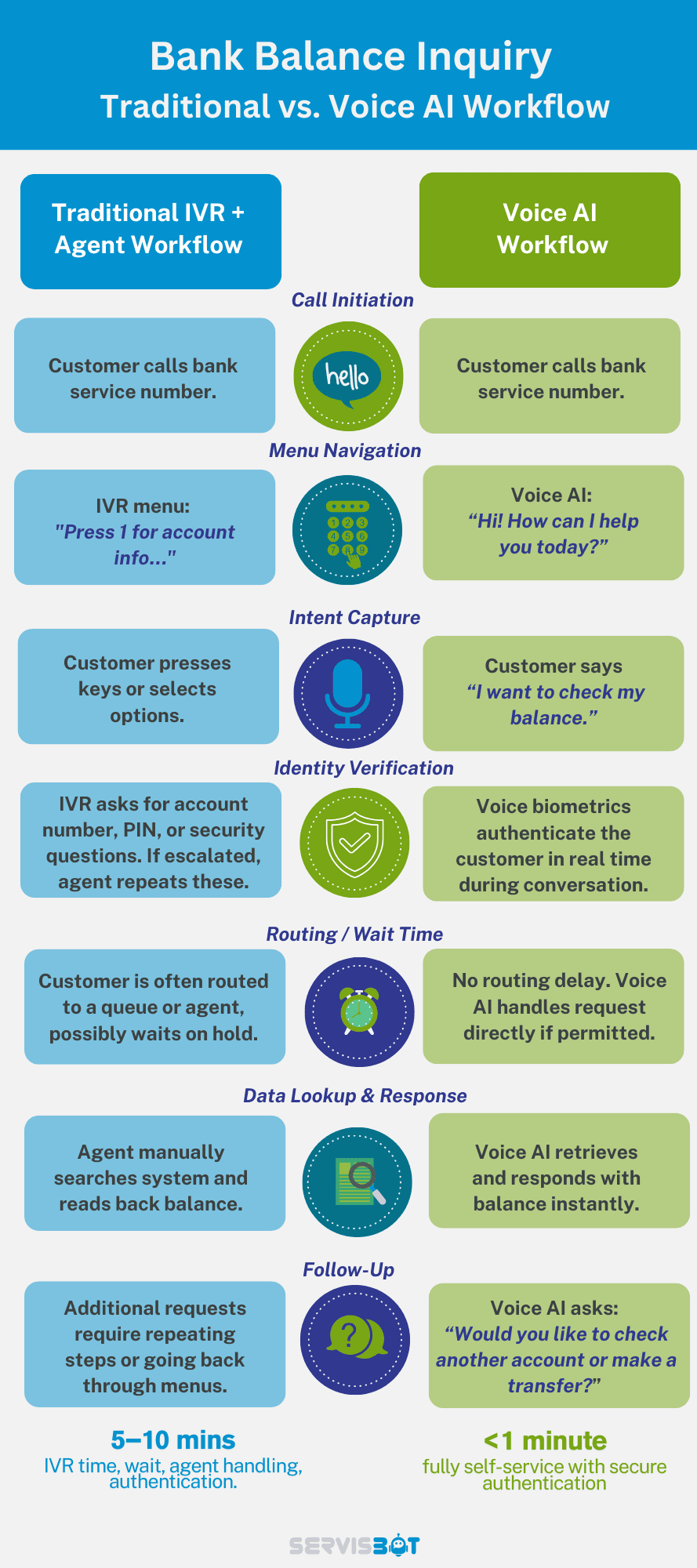Customer Service Transformation, Large Language Model, Voice
Use Cases for Voice AI in Banking
The Transformative Power of Voice AI, fueled by Generative AI and Large Language Models (LLMs)
As customer expectations for fast, personalized, and secure service continue to grow, banks are turning to Voice AI as a powerful enabler of next-generation customer engagement. No longer limited to basic call routing or static menus, Voice AI—powered by Generative AI and Large Language Models (LLMs)—is redefining how banks interact with their customers.
Modern Voice AI systems understand natural language, hold multi-turn conversations, manage sensitive tasks like authentication, and operate seamlessly at scale.
There are multiple high-impact use cases where banks are leveraging Voice AI to improve customer experiences and operational efficiency. This blog highlights how Voice AI not only simplifies customer interactions but also enhances security, reduces costs, and scales service capacity, especially during high call volumes.
- Intelligent Call Routing
- Identity Verification (ID&V)
- Account Inquiries
1.Intelligent Call Routing
Voice AI can greatly enhance customer service by intelligently routing callers to the right place or person, quickly and efficiently. When a customer calls the service number, the voice AI bot can immediately engage in natural conversation, asking questions like, “How can I help you?”
Unlike traditional IVR systems that force callers to press numbers or follow rigid menus, Voice AI uses LLM-powered natural language understanding to interpret the customer’s intent, no matter how they phrase their request.
Depending on the type of support a customer needs, the voice AI understands the intent and routes the query to the correct place. For example, if a customer says, “I lost my card and need to block it” the AI recognizes the intent (card services), and can either handle the task directly (if it’s automated) or route the call to the right department or agent who specializes in lost or stolen cards.
And with enhanced identity verification, a customer can even be authenticated so that the agent has customer information at hand.The AI also can factor in sentiment analysis and urgency detection. If a caller is frustrated or mentions a serious issue, the system can prioritize and escalate the call to a senior agent.
This intelligent call routing helps deliver faster, more efficient, and personalized service that improves customer experience and operational efficiency.. Contact centers and customer service leaders achieve:
- Faster resolution times
- Higher first-call resolution rates
- Fewer call transfers and shorter handling times
- Ability to scale call volumes without additional headcount
2. Identity Verification (ID&V)
Voice AI enhances Identity Verification (ID&V) by providing a secure and more seamless way to verify a customer’s identity during an interaction. Traditionally, customers would have to answer multiple security questions or input PINs, which added time and friction to the experience. With voice biometrics, Voice AI can analyze unique characteristics of a person’s voice, such as pitch, tone, and speaking style, to authenticate their identity in real time.
For example, when a customer calls, the voice AI system captures a voiceprint and matches it against the stored voice profile, similar to how fingerprint or facial recognition works. If the voice matches, the system confirms the identity instantly and securely.
For added protection, multi-factor authentication (MFA) can be layered on top of voice biometrics. This might include device recognition, one-time passcodes (OTP), or knowledge-based questions, depending on the security level needed. By combining these elements, Voice AI ensures robust security while minimizing the effort required from the customer.
In the example above where Voice AI is used for intelligent call routing, using AI-powered ID&V, a caller to the service line can be authenticated early on. So when the call is transferred, the agent has the necessary customer info—saving time and improving the experience.
In banking, this ID&V capability means that customers can access sensitive services, like fund transfers or reporting fraud, quickly and securely. This capability offers many benefits for customers and for the bank such as:
- Near-instant verification
- Enhanced fraud protection
- Lower operational friction
- Compliance with ID&V regulatory standards
3. Account Inquiries
Voice AI simplifies and speeds up bank account inquiries by allowing customers to get real-time information through natural, conversational interactions without needing to navigate complex menus or wait for a human agent.
When a customer calls and asks something like, “What’s my current balance?” or “What were my last few transactions?”, Voice AI uses advanced language understanding (LLMs) to accurately interpret the request, regardless of phrasing. After securely verifying the caller’s identity using ID&V, the AI can instantly access and relay account details, such as balances, recent transactions, pending payments, or deposit confirmations.
Voice AI also supports follow-up questions and multi-turn conversations. For example, a customer might ask, “What’s my balance?”, then follow up with, “Can I transfer $200 to savings?”—all within the same call. The AI maintains context, handles the task, and confirms completion, making the experience smooth and efficient.
Key benefits include:
- Instant access to account data
- Reduced agent load and call center traffic
- 24/7 availability with consistent service quality
Comparing Traditional IVR-Based Voice Workflow with Today’s Voice AI-enabled Interaction
In banking, checking something as simple as your account balance often means navigating frustrating phone menus, keying in account numbers, answering security questions, and often waiting for a human agent. The following infographic best illustrates how transformative the impact of generative AI, large language models, speech recognition, and voice biometrics is for banks and for customers that call into their contact center.
This demonstrates how Voice AI meets customers’ preference for voice communication while delivering significantly on operational efficiency. Banks can now provide personalized, frictionless phone support at scale, slashing voice handling times to one tenth compared with traditional call handling times.
For more information on how Voice AI can help your bank deliver better customer experience and increased operational efficiency and to hear how we have implemented such solutions for other banking customers, please contact us.
